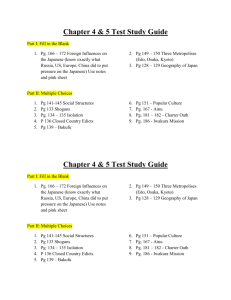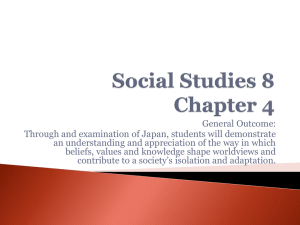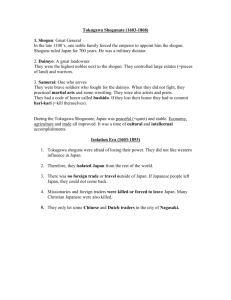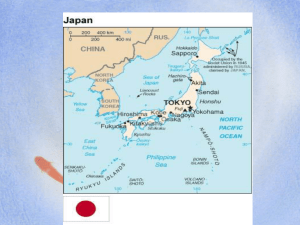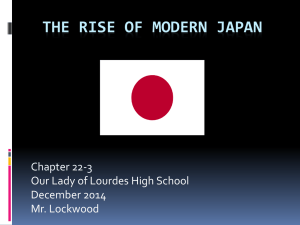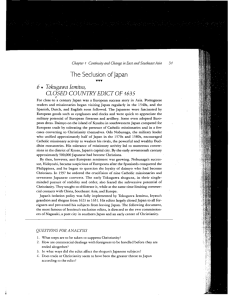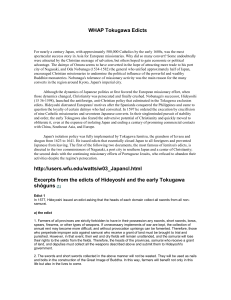Why Did Japan Isolate Itself from Much of the World?, pp. 134-136
advertisement
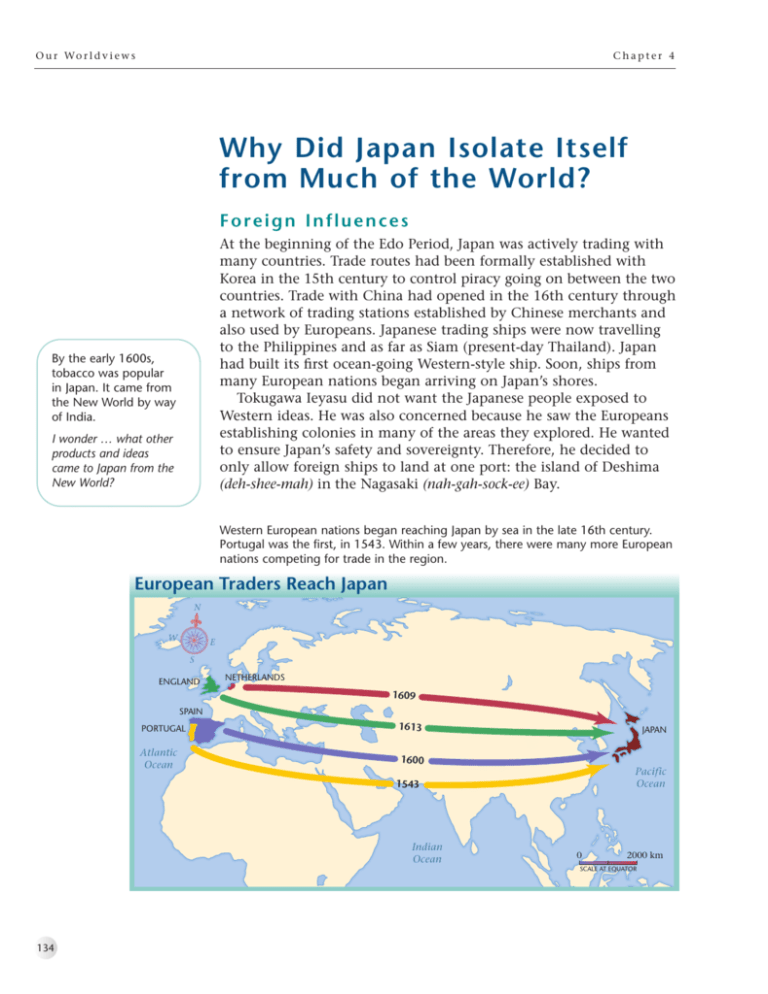
O u r Wo r l d v i e w s Chapter 4 Why Did Japan Isolate Itself from Much of the World? Foreign Influences At the beginning of the Edo Period, Japan was actively trading with many countries. Trade routes had been formally established with Korea in the 15th century to control piracy going on between the two countries. Trade with China had opened in the 16th century through a network of trading stations established by Chinese merchants and also used by Europeans. Japanese trading ships were now travelling to the Philippines and as far as Siam (present-day Thailand). Japan had built its first ocean-going Western-style ship. Soon, ships from many European nations began arriving on Japan’s shores. Tokugawa Ieyasu did not want the Japanese people exposed to Western ideas. He was also concerned because he saw the Europeans establishing colonies in many of the areas they explored. He wanted to ensure Japan’s safety and sovereignty. Therefore, he decided to only allow foreign ships to land at one port: the island of Deshima (deh-shee-mah) in the Nagasaki (nah-gah-sock-ee) Bay. By the early 1600s, tobacco was popular in Japan. It came from the New World by way of India. I wonder … what other products and ideas came to Japan from the New World? Western European nations began reaching Japan by sea in the late 16th century. Portugal was the first, in 1543. Within a few years, there were many more European nations competing for trade in the region. European Traders Reach Japan N W E S ENGLAND NETHERLANDS 1609 SPAIN PORTUGAL 1613 Atlantic Ocean 1600 JAPAN Pacific Ocean 1543 Indian Ocean 0 2000 km SCALE AT EQUATOR 134 W h a t We r e t h e E f f e c t s o f J a p a n ’s P o l i c i e s o f I s o l a t i o n D u r i n g t h e E d o P e r i o d ? The Spread of Christianity Many of the European ships carried Roman Catholic missionaries who wanted to convert the citizens of Japan to Christianity. Between 1549 and 1587, Jesuit missionaries under Francis Xavier converted 150 000 Japanese to Christianity in the Nagasaki area. In 1587, Shogun Hideyoshi ordered all missionaries to leave and later had 26 Franciscan missionaries executed. After the death of Shogun Ieyasu, the Bakufu (bah-koo-foo) became more and more concerned about the increased spread of Christianity in the country. They were concerned that Christians, especially Christian daimyo, would follow their spiritual leaders rather than viewing the shogun as their ultimate authority. Fearing a loss of absolute control, the shoguns decided to isolate Japan, primarily from the Western world. They introduced a series of edicts. Bakufu: the centralized military government, headed by the shogun edict: legal order; a command to the public by an authority Japanese map of the pacific basin. Woodblock print, between 1750 and 1900. 135 O u r Wo r l d v i e w s Chapter 4 The era after the final edicts of national isolation is often referred to as sakoku (sah-koe-koo), meaning “closed country,” even though Japan was never entirely closed. The National Seclusion Policy The Bakufu passed a series of edicts to control the influence of foreigners and to tighten control over the daimyo. The National Seclusion Policy, as it was called, was an effort by the Bakufu to strengthen its authority and maintain a strong centralized government. The National Seclusion Policy developed over six years from 1633 to 1639. It set out controls on the interaction between Japanese and foreigners. The following list presents key items of the edict: Clos ed C ount ry Ed • Jap ict o anes f 163 trave e ships 5 ar lt e stri o for • No Japan eign cou ctly forbi dden ntrie es Anyo s. to ne w e is perm ho a i exec t t e d ttem uted pts t to go ab . • If o do r any J so m oad. resid apanese u st be ing t here returns fr • If , he any must om over teach southern se be p b ut to as after may Christian arbarian deat s i be p h. • No ut in ty or com (Western t o m e sin rs priso it cri mes, ) n. to pu gle tradi ng c t hey rchas ity sh by fo e all a t l • Po reign ship he merc l be perm hand rtug s. ise b itted Japan uese ship roug e s ht orde se ports. are ban ned r will Any fro s b and passe e destro hip disob m y nger e s exe ed and it ying this s cre cuted w . I wonder … how would I feel if I was once allowed to visit other countries but now would be threatened with execution if I did? REFLECT AND RESPOND 1. What aspects of its worldview led Japan to make the decision to close its borders to the Western World? Describe the historical context that led to this key event in Japanese history. 2. Imagine the discussions that must have occurred in the Bakufu before a new closed-country edict was announced. Select one of the statements from the Closed Country Edict of 1635 and act out an informal debate among members of the Bakufu as they decide what to do. 136
